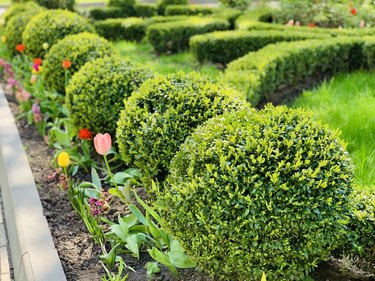
Boxwood (Buxus sempervirens) plants and hedges are chameleons. They can be shaped into orbs, cut into stately hedges, trimmed to form a garden backdrop or grown to stand alone. There are around 70 species of boxwood, and all are slow-growing evergreens that prefer warmer weather. They grow best in USDA plant hardiness zones 5 to 9. Garden designers look to boxwood companion plants to answer five specifications. They are mass, form, line, color and texture. Boxwoods already answer three: mass, form and line. Add the color and texture and your garden is perfect.
Add Color to Your Boxwood Surroundings
Video of the Day
The brilliant green of the boxwood needs to be contrasted with color in order to stand out; otherwise, it is inconspicuous. They stay green during the winter and give protection to the flowering plants growing below or above them. When selecting companion plants for boxwood, consider those that have similar maintenance needs. Roses (Rosa) and daylilies (Hemerocallis) add superlative color to the deep green boxwood background.
Video of the Day
Consider the height of your boxwood and select a plant that is shorter than the background. If the boxwood hedge is tall, you can select a coneflower (Echinacea), but they are only found in Eastern and Central North America. With colors ranging from yellow to deep pink, they provide a lovely contrast, as they grow 2-4-feet tall.
The Power of Texture
Gardens can be beautiful, but they must also be interesting. By adding variegated leaves, stunning colors and different-shaped leaves, the appeal of the garden is enhanced. Gardenias (Gardenia), with their shiny leaves, contrast texturally with the leaves of the boxwood. Plant them next to a tall boxwood to provide shade for the gardenia.
Layering also adds interest to a garden. A row of mid-height boxwood can be flanked by taller plants or flowers, and shorter ones can be planted in front. For a natural, easy look to the garden, plant hydrangeas (Hydrangea), ninebarks (Physocarpus) or lilacs (Syringa) as companions. Hydrangeas are highly recommended. If simplicity is your desire, plant another species of shrub with your boxwood. A Japanese maple (Acer palmatum) planted above the boxwood not only adds contrast in color but draws the eye upward to encompass both the boxwood and the stunning pink-orange tree.
Begonias (Begonia), impatiens (Impatiens) and coleus (Coleus scutellarioides), with its velvety green-rimmed purple leaves, are also significant companion plants to boxwood, as they can be changed out yearly to add interest to your garden. Just be sure that the environmental factors are similar for the boxwoods and the companions you select.
Adding Fragrance to Your Boxwood Garden
Another element to take into account when considering what to plant with boxwoods is the fragrance emitted by many plants and flowers. Lavender (Lavandula), with it spindly stems and feathery blossoms, adds whimsy in addition to putting off a subtle fragrance. Herbs also add to a garden, and thyme (Thymus vulgaris), with its delicately pink flowers topping stems of light green, adds to the look and smell of the garden. Framed by boxwood hedges and planted in layers around the shrubs, the garden becomes complex, fragrant and one to be seen with interest.